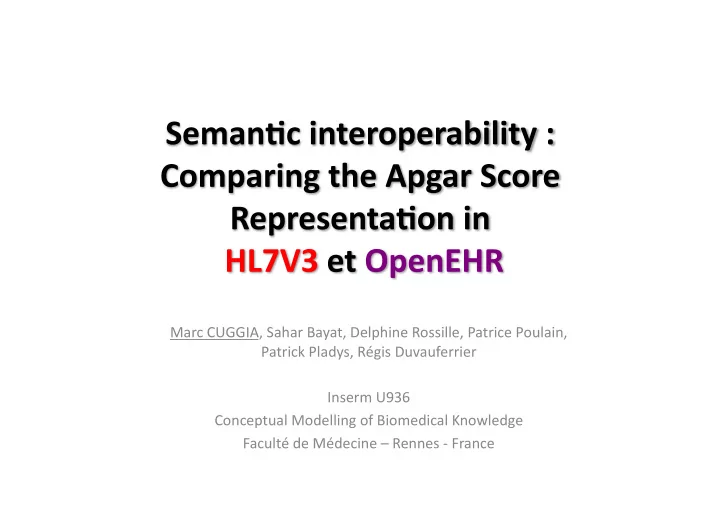

Marc CUGGIA, Sahar Bayat, Delphine Rossille, Patrice Poulain, Patrick Pladys, Régis Duvauferrier Inserm U936 Conceptual Modelling of Biomedical Knowledge Faculté de Médecine – Rennes ‐ France
IntroducKon Seman&c Interoperability Knowledge Models InformaKon Models InformaKon InformaKon System B System A
IntroducKon Terminologies Ontologies ICD, RxNorm, • Terms et concepts of the domain Knowledge Snomed, • DefiniKons : ontologies Models LOINC… Interoperability standards InformaKon • InformaKon structure HL7 , EN13606, Models • messages or documents OpenEHR , DICOM, HPRIM…
IntroducKon Terminology/ontolology Knowledge Models RepresentaKon Interface formalism ? InformaKon Data element Models Rector, A. L. (2001). "The Interface between Informa;on, Terminology, and Inference Models." STUDIES IN HEALTH TECHNOLOGY AND INFORMATICS: 246‐250.
ObjecKves To Compare two relevant informaKon standards HL7 and Open EHR according to ‐ The informa&on representa&on formalism ‐ The interface with the knowledge models
Materiel and Method Virginia Apgar • Apgar score : To assess the health of newborns just a\er childbirth • Score range 0 to 10 • Measured at 1, 5, 10 minutes Score value Pulse rate Breathing Muscle Tone Reflex irritability Skin color No response to 0 <80 absent none cyanosis sKmulaKon Weak or Grimace cry 1 80 ‐ 100 Some flexion acrocyanosis irregular when sKmulated AcKve 2 > 100 strong vive pink movement
HL7 v3 Act Role Link Reference Relationship InformaKon Model (RIM) Act Entity Role Participation Domain Message InformaKon DMIM refinement Model (DMIM) Messages : Documents structures Business process (CDA & Template)
OpenEHR Reference Model Refinement Archetypes ECG APGAR Score Weight MenstruaKon report Pulse rate = Breathing= Birth Adult Menstrual Muscle Tone = Pain Reflex= weight weight Cycle Skin Color= inheritance composiKon
Material and Method Archetype Apgar score (2008) published by (2008) « APGAR score » part of the perinatal DMIM published by Goosen (2005)
Method • EvaluaKon criteria: – What is the degree of formalism of each model ? – Is the context expressed in the model ? – Could we use the model in another context ? – How is the binding with knowledge models
Birth Weight APGAR Birth data SCORE Composi&on
No birth or perinatal context in the OpenEHR Taxonomy
No link between pulse rate and apgar score archetype
Header : archetype metadata : purpose, use, authors (free text) Data DefiniKon Temporality No hierarchy between the data elements (e.g TOTAL)
Study of the InformaKon Models ComparaKve analyses of the representaKons Apgar Score HL7 V3 OpenEHR • lack of organizaKon in the • Formal structure Formalism archetypes hierarchy • Few defined relaKonships degree • Complexity between the data elements • limited Reusability • Modularity like Lego Bricks • Possibility of modularizaKon (CMET : generic model of score) Context • Context is “embedded” • No relaKonship to the context Binding • 2 data linked to LOINC • 2 data linked to LOINC
The terminology binding Knowledge LOINC Models Muscle Tonus Informa&on Muscle tone= < Model Act Role Link Relationsh ip RIM Entity Role Act Participatio n
How to handle the binding to different Knowledge Models? Knowledge LOINC SNOMED Models Observable Finding Muscle Tone Muscle Tone MuscleTone Informa&on Muscle tone= < Model Act Role Link Relationsh ip RIM Entity Role Act Participatio n
How to handle the binding to different Knowledge Models? Knowledge LOINC SNOMED Models Observable Finding Muscle Tone Muscle Tone MuscleTone GREY ZONE Informa&on Muscle tone= < Model Act Role Link Relationsh ip RIM Entity Role Act Participatio n
Discussion & conclusion • Limits : 1 example but which illustrates generic problems • Gap between informaKon and knowledge model : – QuanKtaKve aspect to increase the binding – QualitaKve aspect : • “Easy” to solve if terminology is considered as a flat model (TermInfo IniKaKve) • Need to re‐think the modeling process of both models in a same Kme • More reusable structures of informaKon and a beoer organizaKon of data elements.
Recommend
More recommend